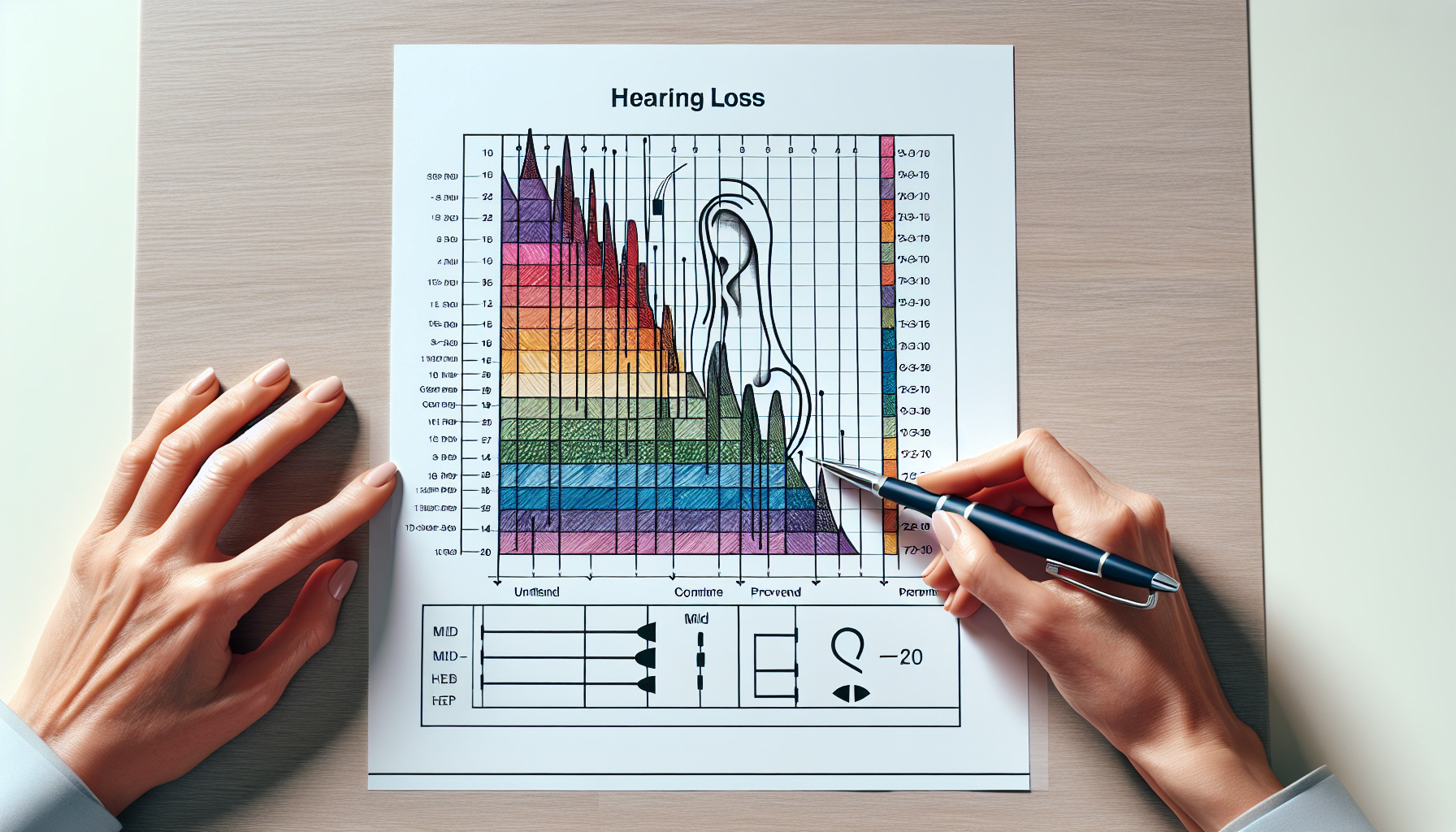In this article, you will gain a comprehensive understanding of the Hearing Loss Chart. This valuable tool provides a visual representation of the different degrees of hearing loss and the corresponding decibel (dB) ranges. It allows individuals to easily identify the severity of their hearing loss and assists healthcare professionals in determining the appropriate interventions and treatments. By exploring the Hearing Loss Chart, you will be equipped with the knowledge to better navigate and manage your hearing health.
Understanding the Hearing Loss Chart
The hearing loss chart, also known as an audiogram, is a visual representation that shows the degree and type of hearing loss a person may have. It is an important tool used by audiologists and healthcare professionals to assess hearing abilities and customize treatment options for individuals experiencing hearing difficulties.
What is a Hearing Loss Chart?
A hearing loss chart is a graph that displays the results of an individual’s audiometric testing. It illustrates the relationship between the pitch or frequency of sounds and the intensity or volume that can be heard by the person being tested. The chart typically consists of two axes – the horizontal axis represents frequency in Hertz (Hz), while the vertical axis represents intensity measured in decibels (dB).
How is a Hearing Loss Chart Measured?
A hearing loss chart is measured through audiometric testing, which involves the use of an audiometer. During the test, the individual wears headphones and listens to a series of tones played at different frequencies and intensities. They indicate when they can hear the sound, and the results are recorded on the chart.
The Importance of a Hearing Loss Chart
The hearing loss chart is of utmost importance in the field of audiology. It serves various purposes, including:
- Identifying and diagnosing hearing loss: By analyzing the pattern of hearing thresholds on the chart, healthcare professionals can determine the presence and severity of hearing loss.
- Determining hearing aid candidacy: The chart helps determine if an individual is a suitable candidate for hearing aids or other assistive listening devices.
- Monitoring hearing health: Regular audiometric testing and tracking hearing loss progression through the chart can provide valuable insights into an individual’s overall hearing health.
Different Types of Hearing Loss
There are three main types of hearing loss:
- Sensorineural Hearing Loss: This type of hearing loss occurs due to damage or dysfunction in the inner ear or the auditory nerve pathways. It can be caused by factors such as aging, exposure to loud noise, genetic factors, or certain medical conditions.
- Conductive Hearing Loss: Conductive hearing loss is caused by a blockage or obstruction in the outer or middle ear that prevents sound from being conducted to the inner ear. Common causes include earwax buildup, ear infections, or abnormalities in the middle ear.
- Mixed Hearing Loss: Mixed hearing loss is a combination of sensorineural and conductive hearing loss. It occurs when there is damage or dysfunction in both the outer and inner ear, as well as the auditory nerve pathways.

The Degrees of Hearing Loss
Hearing loss is categorized into different degrees based on the severity of the impairment. These degrees include:
- Normal Hearing: Individuals with normal hearing have no hearing loss and can hear sounds across the full range of frequencies at a comfortable volume.
- Mild Hearing Loss: Mild hearing loss refers to difficulties in hearing faint or soft sounds, particularly in noisy environments. Conversations may seem muffled or unclear.
- Moderate Hearing Loss: With moderate hearing loss, individuals struggle to hear conversational speech and often require amplification devices or closed captioning to understand speech.
- Moderately Severe Hearing Loss: Those with moderately severe hearing loss have significant difficulty understanding speech without amplification. Loud speech may be necessary for communication.
- Severe Hearing Loss: Severe hearing loss indicates almost total or complete inability to comprehend speech without the use of hearing aids or assistive devices.
- Profound Hearing Loss: People with profound hearing loss cannot understand speech without advanced hearing technology or cochlear implants. They heavily rely on lip-reading and non-verbal communication.
Understanding Speech Audiometry
Speech audiometry is an essential component of a hearing loss chart. It involves various tests that assess an individual’s ability to understand and discriminate speech. These tests include:
- Speech Recognition Testing: This test measures the ability to understand and repeat words or sentences presented at different volumes.
- Speech Discrimination Testing: It evaluates the ability to differentiate between similar-sounding words or sounds.
- Speech Reception Threshold (SRT): The SRT test determines the minimum volume at which an individual can understand speech.

The Hearing Loss Chart and Communication
Hearing loss can significantly impact communication abilities. It can lead to misunderstandings, difficulty following conversations, and feelings of isolation. Understanding the hearing loss chart is crucial for addressing communication challenges, as it allows healthcare professionals to recommend appropriate interventions and strategies. With early intervention and the use of hearing aids or other assistive devices, individuals with hearing loss can enhance their communication skills and maintain active social lives.
How to Read a Hearing Loss Chart
Reading a hearing loss chart requires an understanding of the axes, symbols, and markings on the graph. The frequency and intensity axes represent the pitch and volume of sounds respectively. The degree of hearing loss is marked on the chart, with different symbols indicating the severity of the impairment. It is important to consult with a healthcare professional or audiologist to accurately interpret and understand the results of a hearing loss chart.

Treatment Options for Hearing Loss
There are various treatment options available for individuals with hearing loss, depending on the type and severity of the impairment. These options include:
- Hearing Aids: Hearing aids are small electronic devices worn in or behind the ear to amplify sound and improve hearing.
- Cochlear Implants: Cochlear implants are surgically implanted devices that bypass damaged parts of the inner ear and directly stimulate the auditory nerve.
- Assistive Listening Devices: These devices, such as amplified telephones or TV listening systems, help individuals with hearing loss better understand speech in specific situations.
- Communication Strategies and Rehabilitation: Speech therapy and communication techniques can help individuals with hearing loss compensate for their impairment and improve their ability to communicate effectively.
Prevention and Awareness of Hearing Loss
Preventing hearing loss is essential for maintaining optimal hearing health. Some preventative measures and awareness practices include:
- Hearing Conservation Programs: These programs aim to educate individuals on the importance of protecting their hearing in noisy environments and provide strategies to mitigate the risk of hearing damage.
- Safe Listening Practices: Limiting exposure to loud noises, wearing ear protection in noisy environments, and using volume-limiting features on personal listening devices can help prevent hearing loss.
- Education and Awareness Campaigns: By raising awareness about the causes and consequences of hearing loss, these campaigns promote early detection, encourage regular hearing screenings, and emphasize the importance of hearing care.
In conclusion, understanding the hearing loss chart is vital for assessing and managing hearing loss. It provides valuable information about the type, degree, and configuration of a person’s hearing loss, enabling healthcare professionals to develop personalized treatment plans. By promoting awareness, prevention, and early intervention, individuals can take proactive steps to protect their hearing and optimize their overall well-being.

